But the Washington Senators were a historically bad baseball team, said to have been "First in war, first in peace, and last in the American League."
From the 1901 foundation of the AL until 1960, only 18 times out of 60 did the Senators finish with a record of .500 or better. Only 14 times did they finish as high as 3rd in the AL. Only 6 times did they finish within 7 games of 1st place. They won Pennants in 1924, 1925 and 1933, but 1924 remains the only World Series won by a Washington baseball team. After the 1933 Pennant, only once in 27 years did they even get within 13 games of the Pennant: In 1945, they finished a game and a half out.
The Senators were so identified with losing that, in 1954, Douglas Wallop made them the protagonists of his novel, titled The Year the Yankees Lost the Pennant. The St. Louis Browns had already moved to Baltimore, but, for 1 more season, the Athletics would still be in Philadelphia. He also could have used a fictional team in a city that didn't yet have a big-league ballclub. Or he could have used the Brooklyn Dodgers and had them beat the Yankees in the World Series, which didn't happen in real life until 1955.
It was a retelling of the Faust legend: In Wallop's imagined, as-yet-future 1958, a frustrated middle-aged Senators fan named Joe Boyd says he'd sell his soul to the Devil if it meant that the Senators would win the Pennant. The Devil shows up, and takes him up on the offer, turning him into powerful young slugger Joe Hardy, who arrives in Washington and sparks the Senators on a run. (It may have been influenced by Bernard Malamud's The Natural: His story of mysterious slugger Roy Hobbs came out 2 years earlier. And both players were power-hitting right fielders.)
Spoiler alert: Just when it all seems to be going wrong, the tables get turned, and the Senators win the Pennant anyway.
Ironically, in 1954, for the 1st time since 1948, the Yankees did lose the Pennant. In 1955, the novel was turned into a Broadway musical, titled Damn Yankees. In 1958, it was filmed. It came very close to violating the Hays Code that censored movies at the time: Not only was "damn" considered a profanity (Gone With the Wind got in trouble for having Clark Gable say, "Frankly, my dear, I don't give a damn," but since the line was in the book, it was kept for the film), and a song-and-dance number shows men copying a chorus line, including doing high kicks, while wearing only towels.
Tab Hunter as Joe Hardy, and Gwen Verdon as Lola,
in the film version
In real life, Clark Griffith owned the Senators in part starting in 1912, and in a controlling interest from 1919, until his death in 1955. He was a former player, legitimately a Hall-of-Famer based on his pitching, but was essentially elected for his role in founding the American League. His street cred as a great pitcher lent status to the fledgling League, convincing several players to jump from the National League.
He was the 1st manager of the Chicago White Sox, won the League's 1st Pennant in 1901, then in 1903 became the manager of the New York Highlanders, pieced together from the remnants of the dissolved Baltimore Orioles, and nearly got them to the Pennant in 1904, and to another 2nd place finish in 1906, before retiring as a player and being fired as manager. That team, of course, became the Yankees.
"The Old Fox" had no income aside from the Senators, the ballpark he renamed Griffith Stadium, and his Montana ranch. He had to run the team on a shoestring. If not for mortgaging his ranch and receiving rent from the NFL's Washington Redskins, he would have been wiped out.
In spite of his childhood in segregated Missouri, Griffith had no problem integrating his team. Unlike his tenant, George Preston Marshall, who kept the Redskins as the last all-white team in American professional sports (not counting the mostly-Canadian, and thus mostly-white, NHL), he was willing to add black players, and had already been a pioneer in Latin America by adding white Cubans, eventually adding black Cubans, too.
Griffith died in 1955. He had no children, but had raised 4 nephews and 2 nieces as his own. One of the nieces, Mildred Robertson, married Joe Cronin, who was the shortstop and manager of the 1933 Pennant-winning Senators. When Red Sox owner Tom Yawkey offered Griffith a bundle to take Cronin as shortstop and manager, Griffith, cash-short as always, could not resist.
Yawkey's friendship with Cronin meant that Griffith couldn't lure him back as his heir as Red Sox owner. The conflict of interest also prevented Mildred from being heir, and women in sports leadership roles were frowned upon then, anyway. This is why the other niece, Thelma Griffith Haynes (who, like Mildred, married a Senators player, pitcher Joe Haynes), wasn't made the heir. One of the nephews, Sherry Robertson, was a Senators player and coach, and 2 others, Jimmy and Billy, were minor executives, but none was trusted as the heir.
That left the oldest of the nephews as heir: Calvin Griffith, who took his uncle's family name. He made Thelma the club treasurer, and she gave him her vote on all matters of importance, thus giving him control of 52 percent of club ownership.
By the time teams started moving to other cities in the 1950s, the Senators were a target for minor-league cities looking to move up. In 1958, Calvin Griffith publicly promised he would never move the Senators. Two years later, he broke that promise, moving to the "Twin Cities" of Minneapolis-St. Paul, becoming the Minnesota Twins.
The timing turned out great for Minnesota, and lousy for Washington. By their 2nd season, 1962, the Twins finished 2nd in the AL. In 1965, they won the Pennant. They came close again in 1967, and when Divisional Play began, they won the AL Western Division in 1969 and 1970.
Meanwhile, the replacement team the AL put in Washington, also named the Senators, was, as is typical for expansion teams, terrible, and didn't have a winning season until 1969, and moved after the 1971 season to become the Texas Rangers.
But the Twins declined, because, like his uncle, Griffith wouldn't spend on the team. This time, though, it wasn't out of necessity. It was by choice.
Walleyes are a popular fish in Minnesota. So much so that Griffith successfully appealed to the AL to always have the Twins be scheduled for a roadtrip on the 2nd weekend of May, which is the start of the walleye fishing season. Griffith was so cheap (How cheap was he?), a joke made the rounds that he would go out that weekend, catch his legal limit of walleyes, then take them to the supermarket, and trade them for a year's supply of Mrs. Paul's fish sticks.
Like most MLB owners of the era, he didn't put up with dissent at all. This, more than a late-season fight with one of his players, is why Billy Martin, despite winning the AL West in 1969, his 1st season as a big-league manager, was fired right thereafter. And when star players such as Tony Oliva and later Rod Carew demanded more money, they were marginalized.
In 1978, Griffith was a featured guest at a Lions Club dinner in the Minneapolis suburb of Waseca. And he told them this:
I'll tell you why we came to Minnesota. It was when we found out you only had 15,000 blacks here. Black people don't go to ballgames, but they'll fill up a rassling ring and put up such a chant it'll scare you to death. We came here because you've got good, hardworking white people here.
This is in contrast to Washington: Aside from federal government employees, the District of Columbia's residents had already become majority-black by the time Griffith inherited the team in 1955. Indeed, the site of Griffith Stadium is now occupied by Howard University Hospital, the medical center and medical school, of the leading "historically black college" in America, a.k.a. "the Black Harvard."
Not only was the neighborhood around Griffith Stadium almost totally black by 1955, but the one around the site of the planned new stadium, the one opened in 1961 as District of Columbia Stadium and known since 1969 as Robert F. Kennedy Stadium, was also mostly black. And, to Griffith, that meant poverty and crime, affecting the mostly-white Senators fans.
When Carew heard that Griffith had said what he said at the Lions Club dinner, he said he would never play for him again. Before the 1979 season, he was traded.
In 1984, fed up with the rising costs of running a Major League Baseball team, Griffith sold the Twins to Carl Pohlad, a billionaire financier -- who still ran the team very cheaply, but spent enough to win the World Series in 1987 and 1991.
Griffith died in 1999, and, today, a statue of him stands outside Target Field, home of the Twins since 2010. The statue is warranted, as, technically, he's the father of the franchise. On the other hand, he was a racist asshole. So it's a bit poetic that the statue is bronze, and thus very dark.
Calvin Griffith, the way he preferred to be: Surrounded by white.
After more than a generation of failures for the old Senators, 11 years of it for the new Senators, an interregnum of more than a third of a century, and now the slow climb and postseason failures of the Nationals, Washington, D.C, still hasn't won a Pennant, in either League, since 1933, or a World Series since 1924.
It could be argued that Griffith screwed over both D.C. and Minnesota. After all, not only did D.C. get the short end of the stick, but Minnesota fans had to sit through 21 years of cold Aprils outdoors at Metropolitan Stadium, and then had to endure the Metrodome, one of the worst stadiums ever to host big-league baseball. And, let's not forget, the team didn't win a World Series throughout his ownership, in either place, 1956 to 1984.
And, considering they had a new stadium -- 2, in fact, 1 in suburban Bloomington for the Minneapolis Millers and 1 in St. Paul for the St. Paul Saints -- the Twin Cities were going to get a major league team whether the Senators moved there or not. So we can't say, "Minnesota wouldn't have gotten a Major League Baseball team if not for Calvin Griffith."
But this isn't about whether he was a good guy. (He wasn't.) Or even about whether he was a good owner. (He wasn't.) It's about whether the move was the right idea. (Even if he publicly gave an evil reason for it.) Was moving the Senators, and moving them to Minnesota, justified, for non-racist reasons? Let's find out: You've heard the case for the prosecution. Here's the case for the defense:
Top 5 Reasons You Can't Blame the Washington Senators for Moving to Minnesota
5. Ballparks. What became known as Griffith Stadium opened in 1911, on the site of the Senators' 1st home, which burned down early that year. (The same thing happened with the Polo Grounds in New York that year.) The new stadium was built in concrete and steel, and by Opening Day -- only a month after the fire -- 16,000 seats were ready and filled by fans, among them President William Howard Taft. (In a retroactive irony, considering Calvin Griffith, the stadium was built mostly by black construction workers.)
Construction was declared complete in late July. The stadium was expanded in 1924, just in time for their World Championship season. This expansion gave the double decks down the baseline a greater height than those behind home plate. This, plus the angling of the center field fence around a tree, resulted in a very strange look for the stadium.
Even with a bleacher section in front of the left field wall, in addition to the one behind it, for football, the stadium's capacity topped out at around 35,000. (Redskin fans complaining about RFK Stadium having just 56,000 fans, and wondering when they'd get a larger stadium, forgot that RFK was the larger stadium.) For baseball, Griffith Stadium's capacity was 27,410, the lowest in the major leagues after the Cleveland Indians stopped playing home games in 21,000-seat League Park after 1946 and moved all their games into the 85,000-seat Municipal Stadium.
A painting based on a black & white photo.
The center field "notch" can be clearly seen.
In contrast, in 1956, Metropolitan Stadium opened -- advertised as being equidistant from the downtowns of both Minneapolis and St. Paul, thus appealing to both cities without slighting either -- with 18,000 seats. By 1960, it had been expanded to 30,000 seats, with potential for more. (It was 40,000 by the 1965 Pennant season and 45,914 for the Playoff season of 1970. But it never seated more than 48,446 for football, which, combined with Minnesota's cold weather, led to the building of the Metrodome.)
The Met also had a weird look: One deck along the 3rd base line and in center and right field, two decks down the 1st base line and in left field, and three decks behind home plate. Somebody said it looked like an Erector set that a kid was playing with, and then his mother called him away to dinner, and he never finished it.
A postcard of The Met
The D.C. government, then under the control of the federal government, wouldn't build the Senators a new ballpark. But the federal government, through its Department of the Interior, was willing to, and did build D.C. Stadium, which originally seated 43,500 for baseball and would peak at 45,596. (The Department of the Interior still runs what's now Robert F. Kennedy Memorial Stadium.)
But it wouldn't be ready for baseball until April 1962 (it was ready for football in October 1961), and so Griffith needed a more appropriate stadium as soon as possible. Minnesota had one. It also had a real hunger for the majors, as you'll see next.
4. The Twin Cities. The Minneapolis Millers and the St. Paul Saints battled it out for local, and American Association, supremacy throughout the 1st 6 decades of the 20th Century. The Millers won 10 Pennants, in 1896, 1910, '11, '12, '15, '32, '35, '55, '58 and '59. The Saints won 2, in 1924 and '48.
The Millers were a Boston Red Sox farm team in 1938, so Ted Williams played for them. They were a New York Giants farm team in 1951, so they became Willie Mays' last team before reaching the majors. Other Millers who went on to major league success include Roger Bresnahan, Jimmy Collins, Gavvy Cravath, Red Faber, Zack Wheat, Hoyt Wilhelm, Bill White, Orlando Cepeda, Felipe Alou and Carl Yastrzemski. (They were again a Red Sox farm team when the Twins arrived.) Great players for the Saints included Ginger Beaumont, Lefty Gomez, Duke Snider and Roy Campanella.
In addition to their natural geographical rivalry, for a time, the Millers were a farm team of the Giants, and the Saints of the Brooklyn Dodgers, and the Giant-Dodger rivalry also came into play there.
Minnesota wanted major league ball very badly. They almost got it for the 1958 season: As the Millers' parent club, and wanting to get out of the Polo Grounds and its deteriorating Washington Heights neighborhood, Giants owner Horace Stoneham decided in 1957 to move to Minneapolis and Metropolitan Stadium. But Dodger owner Walter O'Malley decided to move to Los Angeles, and talked Stoneham into going to San Francisco instead. (This also explained the Giants giving up the Millers as their top farm club.)
Hennepin Avenue, downtown Minneapolis, 1961
The Twins came in for the 1961 season, and, despite the team being in what turned out to be the last year of noncontention, attendance went up from 9,655 per home game in the last Washington season to 15,611, over 2,000 more than they had ever gotten in Washington. (They peaked at 13,254 in the baseball-hungry 1st season after World War II, 1946.)
And the fan bases of the Millers and the Saints came together to root for one team, just as the Giant and Dodger fan bases would soon do for the Mets. Indeed, the original Twins logo, which has been revived and updated at Target Field, reflects this. Note the M and StP monograms as they reach across the river to form a human bridge. Their names are Minnie and Paul.
And while the Minneapolis Lakers got moved to Los Angeles in the summer of 1960, the NFL brought the Land of Lakes into the fold with the Minnesota Vikings in 1961. And the NHL's 1967 expansion included the Minnesota North Stars. Both the ABA and the WHA would put teams in Minnesota, and it was the problems with the leagues, not the Twin Cities market, that doomed those teams.
No, if you were an MLB team owner in the 1950s, and you wanted to move, Minneapolis-St. Paul was a great place to go. Whatever their flaws, Horace Stoneham and Calvin Griffith both knew this.
3. The Baltimore Orioles. It's only 40 miles between the sites of Memorial Stadium in Baltimore and Griffith Stadium in Washington. The arrival of the O's in 1954 ate up a lot of the Senators' support in the suburbs of Maryland.
It wasn't just the difference in talent that emerged, with the O's becoming contenders in 1960, coming close to the Pennant in 1964, winning the whole thing in 1966 and 1970, and also winning Pennants in 1969 and 1971. In the 18 seasons from the Orioles' arrival in 1954, as very much still an extension of the sad-sack Browns, until the Senators left in 1971, there was never a season in which Washington topped Baltimore in per-game attendance.
And while the Orioles had a more modern stadium with a serious advantage in parking from 1954 to 1961, the last season of Griffith Stadium, that advantage was more than wiped out by Opening Day 1962: D.C. Stadium had more parking. And the neighborhood advantage was also eliminated: People talk about how bad the neighborhood around RFK Stadium is, but it's never been as bad as was faced at Yankee Stadium, or Comiskey Park in Chicago, or Tiger Stadium in Detroit were in those stadiums' last few decades. And it's not like there isn't a ghetto between downtown Baltimore and Memorial Stadium.
It also didn't help that the Orioles and the Senators were in the same league. With the former exception of New York, which had 3 teams from 1903 to 1957, every other 2-team city had their teams split between the Leagues: Boston (1901-1952), St. Louis (1902-1953), Philadelphia (1901-1954), Chicago (1901-present), Los Angeles (1961-present), New York (1962-present), San Francisco/Oakland (1968-present).
Even in different cities in the same State, it worked out that way: Ohio (1901-present), Missouri (1955-67 and 1969-present), Florida (1998-present), Texas (1972-2013). Until the Houston Astros got bumped over to the American League in 2014, Pennsylvania was the only exception among 2-team States. (California, of course, has 5 teams: 3 in the NL, 2 in the AL.)
But when the Orioles arrived in 1954, from then until 1971, there were 2 teams in the same League within 40 miles. Had they been in different Leagues, as the O's and Nats have been since 2005, fans could see American League games and players in Baltimore, and National League games and players in Washington. (Or, had things turned out differently, vice versa.)
Just as Orioles owner Peter Angelos stood in the way of an expansion or moved team in Washington in the 1990s, claiming he would lose 1/4 of his fan base if that happened, Calvin Griffith knew in the latter half of the 1950s that a lot of Marylanders were going to Baltimore instead of Washington to get their baseball. And the newly-arrived Orioles weren't going anywhere. So the old Senators had to go.
As it turned out, Angelos was wrong: The Orioles' attendance took a nosedive in 2002, 3 years before the Nationals arrived. Why? Because 2001 was Cal Ripken's last year. The loyalty of a lot of fans, both in the Baltimore area and in the Washington area, was to him, not to the Orange & Black. Once Cal retired, not nearly as many fans started coming up from Prince Georges County, the District, or Virginia to see the Orioles, who no longer provided either Cal or winning baseball.
Maybe that's why Angelos dropped his objection when Commissioner Bud Selig announced that the Montreal Expos were being moved to Washington: He knew his best excuse had been exposed as a bad guess.
2. They Were Immediately Replaced. The American League, under pressure from the politicians who wanted easy access to baseball, added an expansion team to Washington, along with the Los Angeles Angels, for the 1961 season. So it's not like Washington was without baseball, however bad it may have been. (The "New Senators" were so bad that, as the Vietnam War escalated and D.C. became a cauldron of protest, they were called "last in war, last in peace, and last in the American League.")
RFK Stadium, set up or baseball, in the "New Senators" era
No, Washington still had a baseball team. Until 1971. And you can't blame Calvin Griffith for that move:
1. Washington, D.C. It simply wasn't a good baseball town at the time. Essentially, there were 2 things that mattered in D.C.: The federal government and the Redskins. President Richard Nixon said, "All anybody in Washington cares about is the Redskins. They don't give a damn about the Smithsonian or the Kennedy Center." (And that wasn't just sour grapes over losing to John F. Kennedy in 1960: Government officials might have cared about it, but Washingtonians never really have.)
The fans who tended to show up, first at Griffith Stadium, and then at D.C./RFK Stadium, were middle-class federal government employees, who came from all over the country. Even when they did go to games, it was usually to root for their hometown teams. A Congressional aide from Chicago going to see the Senators play the Chicago White Sox was going to root for the White Sox. An Army Lieutenant from New Hampshire, working at the Pentagon, getting an evening's pass would go to the ballpark and root for the Boston Red Sox to beat the Senators.
When Bob Short -- who, oddly enough, was also the owner who moved the Lakers out of Minnesota in 1960 -- announced that the new Senators were moving to Dallas after the 1971 season, Congress did not pressure the baseball establishment to get them a new team. Commissioner Bowie Kuhn, despite growing up in D.C., did nothing to stop that move. When the final home game was played on September 30, 1971, only 14,461 fans showed up. (And rioted at the end, blowing a win for the Senators and getting the game forfeited to the Yankees.) And when a deal to move the San Diego Padres to Washington for the 1974 season began to fall apart, neither Kuhn nor Congress stepped in to save it.
It also didn't help that the locations weren't great. It wasn't just that Griffith Stadium and, later, RFK Stadium were built in black neighborhoods. It was that the public transportation wasn't great. It wasn't until 1976 that Washington's Metro opened, with the Stadium-Armory stop making it easy to get from anywhere in the metro area to RFK. It wouldn't be until 1991 that the Shaw-Howard University stop opened, providing access to the former location of Griffith Stadium.
It was even worse if you were trying to get to a University of Maryland football or basketball game: The College Park station didn't open until 1993. And Largo Town Center, the Landover station used for the Redskins' new stadium, didn't open until 2004, 7 years after the Bullets/Wizards and Capitals left that area and moved into downtown Washington -- and the Redskins moved out there, across the Beltway from the Capital Centre site.
Despite the old Senators/Twins franchise's ups and downs, the worst season the Twins have ever had for per-game attendance, 8,129 in 1974, is still better than what they got in 51 of their 60 seasons in Washington. And despite the ups and downs of the new Senators/Rangers, the best per-game attendance they got in their 11 seasons in Washington, 11,335 in 1969, has been topped in all but their 1st 2 seasons in Arlington, Texas. (Not since 1988 have they even gotten below 24,000.)
Today, with the Nationals in town, a relatively new ballpark (Nationals Park opened in 2008), easily accessible via public transportation (the Navy Yard station on the Green Line), a heavily-grown market due to the explosion of the D.C. suburbs in both Maryland and Virginia, a growing white middle class and a growing black middle class, a regional TV network (MASN) to drum up local support, and a promotions arm of Major League Baseball that knows a hell of a lot more of what it's doing than it did in 1960 and 1971, would anyone even think of moving the current MLB team out of Washington? As their biggest current star, Bryce Harper, might say, "That's a clown question, bro."
A recent full house at Nationals Park
It was not a clown question in 1960, or in 1971. Now, no one would move the Nationals. But can Calvin Griffith -- guilty though he was of racism and cheapness -- be blamed for moving the old Senators to Minnesota in 1960?
VERDICT: Not Guilty.
In 2015, with both teams in Playoff contention most of the way, and good public transportation to both Nationals Park in Washington and the 1992-opened Oriole Park at Camden Yards in Baltimore, the Nationals averaged 32,343 fans per game; the Orioles, 29,374 -- in each case, better than the O's got in the days in which they drove the new Senators to Texas, and a lot better than the O's got in the days in which they drove the old Senators to Minnesota.


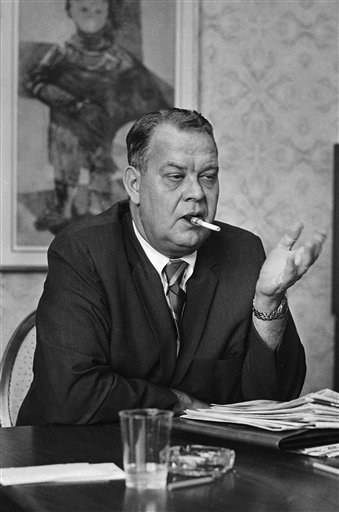


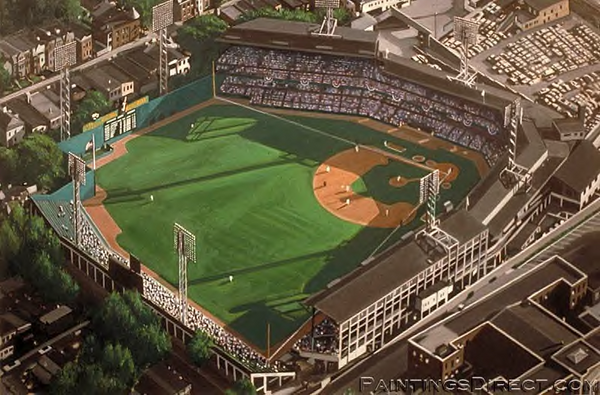

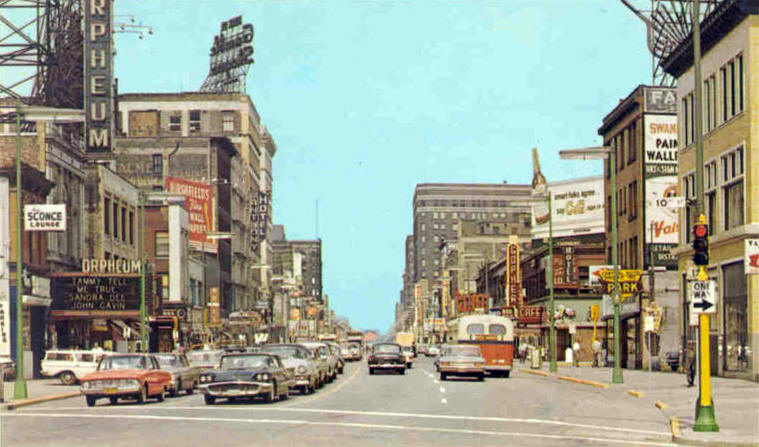

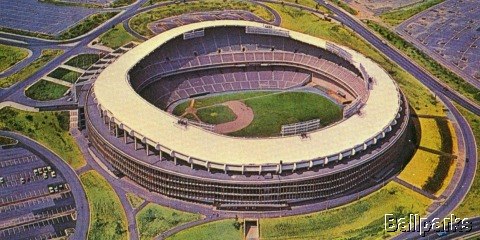
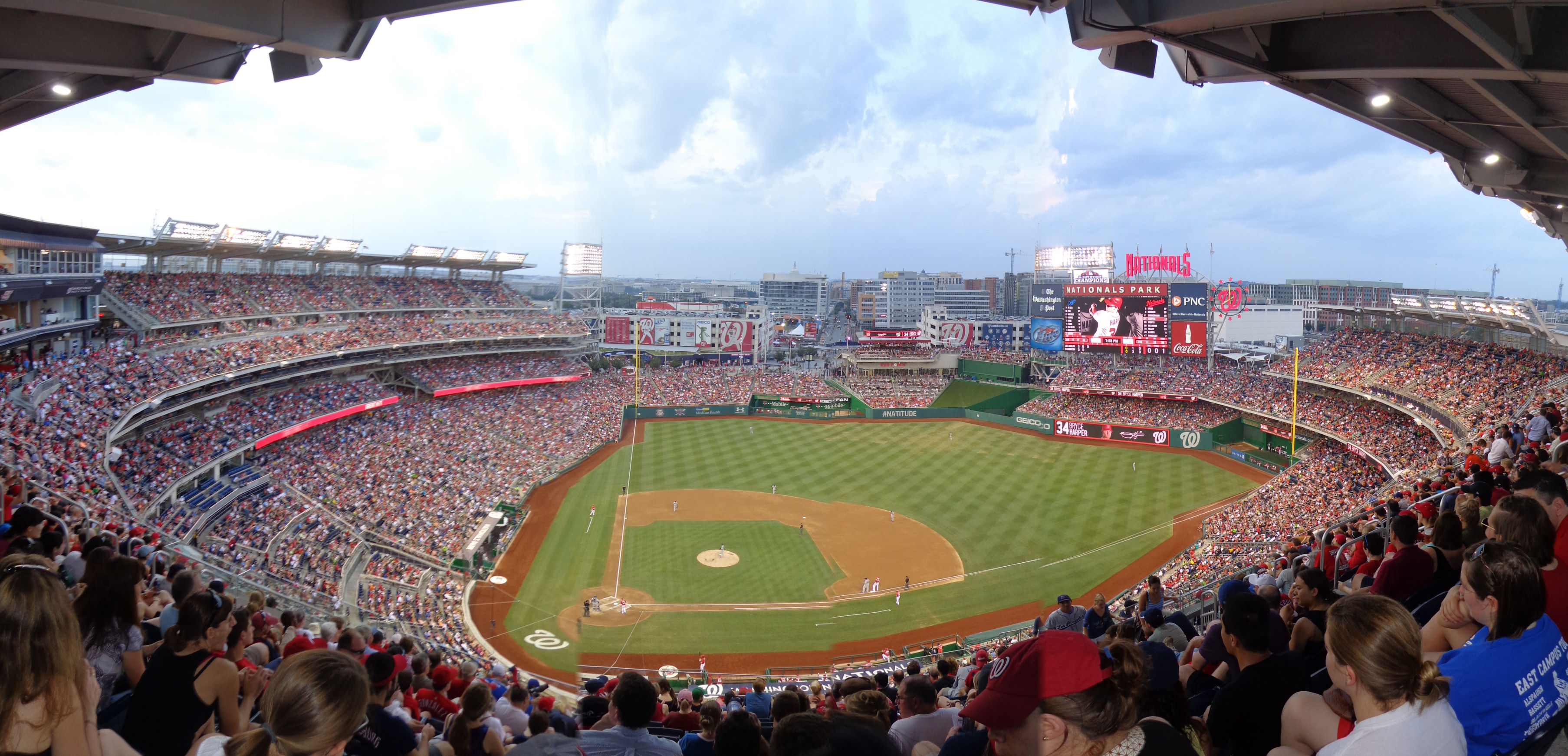

No comments:
Post a Comment